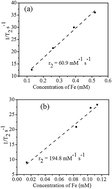Effect of core–shell nanoparticle geometry on the enhancement of the proton relaxivity value in a nuclear magnetic resonance experiment
Abstract
This work illustrates the effect of core–shell nanoparticle geometry on the enhancement of the proton relaxivity value in a nuclear magnetic resonance experiment. Chemically synthesized CoFe2O4–MnFe2O4 core–shell nanoparticles were chosen as a candidate material. A two step methodology was used to synthesize the core–shell nanoparticles. In the first step, CoFe2O4 seed nanoparticles were synthesized and in the second step a MnFe2O4 phase was grown over seed CoFe2O4 nanoparticles to form the core–shell geometry. Characterization of the as-synthesized nanoparticles by diffraction methods, electron microscopy and X-ray photoelectron spectroscopy confirmed the formation of uniform core–shell nanoparticles. Magnetic measurement revealed the superparamagnetic nature of the as-synthesized core–shell nanoparticles. The transverse proton relaxivity values obtained by the nuclear magnetic resonance experiment conducted at room temperature using a field of 9.4 T in the presence of single phase CoFe2O4, MnFe2O4 and CoFe2O4–MnFe2O4 core–shell nanoparticles were 60.9 mM−1 s−1, 83.2 mM−1 s−1 and 194.8 mM−1 s−1 respectively. This result clearly illustrated that a greater magnetic inhomogeneity induced in the medium surrounding the core–shell nanoparticles containing two different magnetic phases yields the highest value for the transverse proton relaxivity.


 Please wait while we load your content...
Please wait while we load your content...